Wal-mart Stores沃尔玛 SWOT 2010
- 格式:pdf
- 大小:97.04 KB
- 文档页数:11
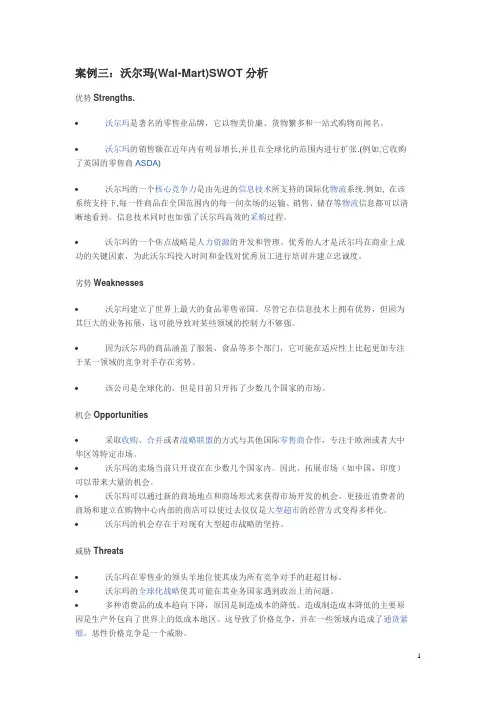
案例三:沃尔玛(Wal-Mart)SWOT分析优势Strengths.∙沃尔玛是著名的零售业品牌,它以物美价廉、货物繁多和一站式购物而闻名。
∙沃尔玛的销售额在近年内有明显增长,并且在全球化的范围内进行扩张.(例如,它收购了英国的零售商ASDA)∙沃尔玛的一个核心竞争力是由先进的信息技术所支持的国际化物流系统.例如, 在该系统支持下,每一件商品在全国范围内的每一间卖场的运输、销售、储存等物流信息都可以清晰地看到。
信息技术同时也加强了沃尔玛高效的采购过程。
∙沃尔玛的一个焦点战略是人力资源的开发和管理。
优秀的人才是沃尔玛在商业上成功的关键因素,为此沃尔玛投入时间和金钱对优秀员工进行培训并建立忠诚度。
劣势Weaknesses∙沃尔玛建立了世界上最大的食品零售帝国。
尽管它在信息技术上拥有优势,但因为其巨大的业务拓展,这可能导致对某些领域的控制力不够强。
∙因为沃尔玛的商品涵盖了服装、食品等多个部门,它可能在适应性上比起更加专注于某一领域的竞争对手存在劣势。
∙该公司是全球化的,但是目前只开拓了少数几个国家的市场。
机会Opportunities∙采取收购、合并或者战略联盟的方式与其他国际零售商合作,专注于欧洲或者大中华区等特定市场。
∙沃尔玛的卖场当前只开设在在少数几个国家内。
因此,拓展市场(如中国,印度)可以带来大量的机会。
∙沃尔玛可以通过新的商场地点和商场形式来获得市场开发的机会。
更接近消费者的商场和建立在购物中心内部的商店可以使过去仅仅是大型超市的经营方式变得多样化。
∙沃尔玛的机会存在于对现有大型超市战略的坚持。
威胁Threats∙沃尔玛在零售业的领头羊地位使其成为所有竞争对手的赶超目标。
∙沃尔玛的全球化战略使其可能在其业务国家遇到政治上的问题。
∙多种消费品的成本趋向下降,原因是制造成本的降低。
造成制造成本降低的主要原因是生产外包向了世界上的低成本地区。
这导致了价格竞争,并在一些领域内造成了通货紧缩。
恶性价格竞争是一个威胁。
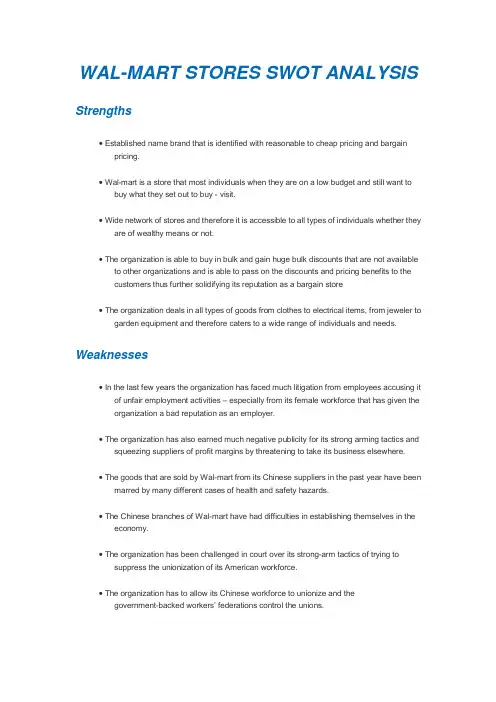
WAL-MART STORES SWOT ANALYSIS Strengths•Established name brand that is identified with reasonable to cheap pricing and bargain pricing.•Wal-mart is a store that most individuals when they are on a low budget and still want to buy what they set out to buy - visit.•Wide network of stores and therefore it is accessible to all types of individuals whether they are of wealthy means or not.•The organization is able to buy in bulk and gain huge bulk discounts that are not available to other organizations and is able to pass on the discounts and pricing benefits to thecustomers thus further solidifying its reputation as a bargain store•The organization deals in all types of goods from clothes to electrical items, from jeweler to garden equipment and therefore caters to a wide range of individuals and needs.Weaknesses•In the last few years the organization has faced much litigation from employees accusing it of unfair employment activities – especially from its female workforce that has given theorganization a bad reputation as an employer.•The organization has also earned much negative publicity for its strong arming tactics and squeezing suppliers of profit margins by threatening to take its business elsewhere.•The goods that are sold by Wal-mart from its Chinese suppliers in the past year have been marred by many different cases of health and safety hazards.•The Chinese branches of Wal-mart have had difficulties in establishing themselves in the economy.•The organization has been challenged in court over its strong-arm tactics of trying to suppress the unionization of its American workforce.•The organization has to allow its Chinese workforce to unionize and thegovernment-backed workers’ federations control the unions.Opportunities•The current economic crisis has decreased the disposable income of many individuals and thus has caused many individuals and households to lower their expectations and toshop for bargains, thus Wal-mart stands to gain in such a situation.•The inflation in the economy is on the decline and the economy is on the brink of deflation thus it may mean that Wal-mart is able to provide its customers with increased bargains.•Many retail organizations are going out of business due to the reduction in disposable incomes. This can help Wal-mart by increasing its customer base due to the bargainsthat it can provide its customers.•Due to the cheap rate that the organization is able to buy its products from suppliers, it is able to provide customers with even bigger bargains to encourage them to shop atWal-mart.Threats•The big name retailers such as M&S are giving having huge sales such as 50% off sales;this is difficult for Wal-mart to compete with, as its profit margins are not that great oneach unit.•The reduction in disposable income of customers and the looming recession and fears of job losses have caused individuals to curtail their shopping and this is a huge threat toWal-mart, which relies on consumer spending.。

沃尔玛在华的SWOT分析沃尔玛从一个乡村小镇的小杂货店成长为世界企业500强之首的大型跨国零售业帝国,其影响因素是多方面的。
1996年中国首家沃尔玛购物广场和山姆会员店同时开张,标志着沃尔玛正式进入中国市场。
面对市场环境的变化,许多企业都通过再定位策略在保持原有优势的基础上寻求突破。
沃尔玛是世界零售业的巨头,以“天天平价”作为其主要市场定位策略,赢得了平民消费者的青睐,在人们的心目中树立了“质优价廉”的企业形象。
它从一个小小的便利店到世界《财富》五百强之首,一夜之间沃尔玛的商业神话传遍世界。
以下从沃尔玛内外环境的变化对其进行SWOT分析。
首先,分析沃尔玛的内外环境因素:沃尔玛领先高效的信息系统备受业界推崇。
借助自己的商业卫星,沃尔玛便捷地实现了信息系统的全球联网。
通过这个网络,全球4000多家门店在一小时之内对各种商品的库存、上架、销售量全部盘点一遍。
内外部信息系统的紧密联系使沃尔玛能与供应商每日交换商品销售、运输和订货信息,实现商店的销售、订货与配送保持同步。
而现阶段,发展中国家的商业环境束缚了沃尔玛这一优势的发挥。
在发展中国家大多数供应商信息化水平比较低,只能和沃尔玛进行简单的数据交换。
制造商对沃尔玛有着矛盾的心态,制造商既离不开沃尔玛强大的分销能力,又无法忍受其对价格的压榨。
目前美国乃至世界对于沃尔玛正在破坏就业并压制薪酬水平的指责不断增多,有些地区的抵制活动正不断升级。
同时,外部竞争给沃尔玛带来的压力,沃尔玛虽然还保持着美国零售业龙头的位置,但Target、西尔斯、凯马特这些强大对手一直虎视眈眈,特别是美国第二大折扣店Target的成长速度远远高于沃尔玛。
其次,沃尔玛SWOT矩阵构造。
S(优势): 1. 良好的企业和品牌形象。
在沃尔玛购物可以体验到“一站式”的服务。
2. 规模经济、天天平价、产品多样化种类齐全、强大的物流系统。
3. 管理人性化,将员工视为伙伴。
4. 有世界范围内最优秀的供货商,并通过自己的大规模采购获取更好的价格。
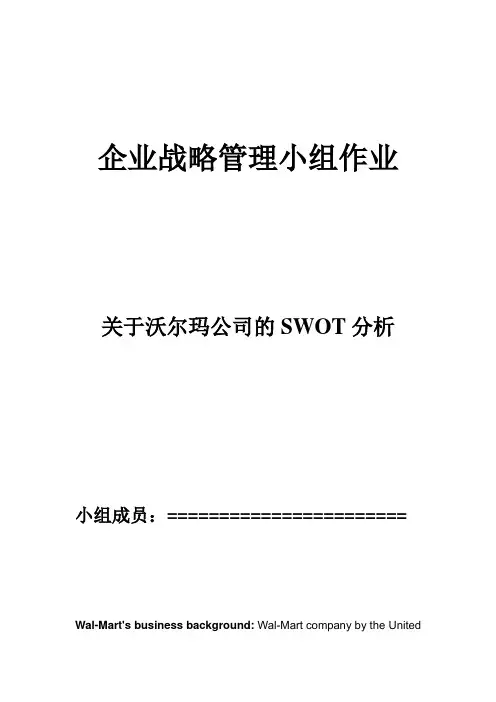
企业战略管理小组作业关于沃尔玛公司的SWOT分析小组成员:======================= Wal-Mart's business background: Wal-Mart company by the UnitedStates retail legend Sam Walton in Arkansas in 1962 set up. After forty years of development, the company has become the world 's largest private employer and the largest chain, in the global 14 countries opened more than 7000 stores, the total number of employees more than 2000000 people, a weekly visit Wal-Mart customers totaling 176000000.Wal-Mart entered China in 1996, in Shenzhen opened its first Supercenter and Sam's club. The Wal-Mart global procurement center headquarters set up in Shenzhen in 2002. After twelve years of development, the current Wal-Mart in the country has a total of 63 city opened 115 stores, including Wal-Mart shopping plaza, Sam's club, Wal-Mart store in three formats, including Wal-Mart shopping plaza in 110, Sam's Club 3, a community shop 2, at the same time have Haoyouduo 35% stake. Wal-Mart has in China created more than 50000 jobs.As a good corporate citizen, Wal-Mart since entering the China will actively participate in community service and charity events, twelve years accumulative total to various charities donated more than $57000000 of goods and capital. Wal-Mart attaches great importance to environmental protection and sustainable development, and environmental protection 360 into the concept of Wal-Mart's daily work of every link, while also encouraging partners become the Wal-Mart environmental protection 360 part of the plan, a common commitment to China 's environmental protection and sustainable development.Elsewhere, the Wal-Mart in China always adhere to the company's fine tradition, that is good to focus on every restaurant, every good customer service. Committed to the" everyday low price" to provide customers with a full range of high quality products and friendly service. Wal-Mart opens a market every time in China, both for the local introduction of advanced technology and innovative retail concept retail. By promoting a healthy competition, we hope to continue to improve the management level and service quality, so as to contribute to the prosperity of local economyWal-Mart in China business always adhere to the local procurement, through the purchase of high-quality products for the local to provide more employment opportunities, supports the local manufacturingindustry, promoting the development of local economy. At present, the products sold by Wal-Mart in China local products reached more than 95%, and nearly 2 ten thousand supplier to establish a cooperative relationship. We always treat our suppliers as partners, and suppliers of common development. In 2008 September, by the Shanghai News - supplier satisfaction evaluation Office Center released" 2008 supplier satisfaction survey report", it again was named " comprehensive satisfaction chain stores". In addition, Wal-Mart annual direct procurement of Chinese goods exports amount to about $9000000000. Wal-Mart and Chinese consumer goods manufacturers work closely together, share our information and resources, and support manufacturing enterprises to improve production, technology and management level; the world's leading retail techniques and experience to promote China, the domestic retail industry to raise the level of.Wal-Mart 's internal strengths ( S )In 1, management of highly standardized, philosophy of science. Wal-Mart all management through information technology to complete, no matter the managerial staff of the headquarters or mall sales are in accordance with the instruction of computer work, will not randomly. Wal-Mart in the price of domestic enterprises is not the killer and its advanced management concepts and scientific management;In 2, a highly developed information technology. Wal-Mart in the information technology investment spare no effort, specifically responsible for the software design engineers have more than 2000, China and the United States headquarters linkages by satellite, the application of computer technology to get in by every opening;3, business promotional features. Wal-Mart store layout is very active, in the commodity sales promotion is also very distinctive. Wal-Mart is not completely at the expense of suppliers and their own interests to do promotions, but very exquisite skill, the skill in the consumer psychology made a lot of efforts. In addition to the commodity demonstration, time-limited sales promotions, and arcade entertainment promotional activities and other aspects are very distinctiveIn 4, the training system of. Wal-Mart employees from entry to the entry after training are very perfect, training for quite a long time, Chinese employee training before the shortest amount of not less than 3 months, after the training staff for the positions of knowledge very comprehensive;In 5, a strong logistics system ( mainly referring to foreign ). Walmart has not yet large-scale in the domestic set up distribution centers, only in Yantian Port has a distribution center of Guangdong Province, all the stores for distribution. And Guangdong Province shop, usually require purchasing localization, part no local procurement of goods required Shenzhen to set up offices in the local suppliers for distribution;In 6, the United States of America brand commodity prices have obvious advantages. This is not reflected in the price sign, and reflected in the purchase rebates. For example, the United States of America Procter & gamble on Chinese domestic businesses to supply price is the same, but as Procter & Gamble's biggest clients, Wal-Mart in the United States each year can be P & G company headquarters made substantial procurement commission. This description if blindly in some big brand goods and Wal-Mart are price war, the loss will be larger;7, brand advantage. Wal-Mart is wearing the world the first halo, this brand is absolutely can not be ignored, for example, many of the retail industry the ideal of the youth is the hope to be able to enter the Wal-Mart, Wal-Mart brand advantages brought about by lethality and charisma is any cannot replace.In 8, management of human nature, the enterprise culture the importance of human resource management, the staff as a partner, outstanding talent.Wal-Mart's internal disadvantages ( W )1, although has the leading IT technology, but because it stores allover the world, this span will lead to some aspects of the control force not strong enough. Huge scale, bring on the management challenges, problems are more.In 2, fair wages and welfare treatment, currently in the country is very common. ( in foreign countries their government's trade union causes, so foreign employees will be better ). As you all know, oppression of suppliers. Many suppliers are afraid to talk about price and wal-mart. There is so large a group, including differences must be serious.In 3, the company so far, all the local branch, is still the only accredited senior director, below the middle level is the local staff, and this company future localization full development, mutual contradiction. Cause to the future development of advanced local management staff shortage, local employees in the personal future occupation career planning development boundaries : local management staff is easy to lose, not conducive to the company's future in China for the global procurement center development strategy orientation, training mode to the occupation skill, has neglected to employee occupation ethics and occupation standard education and training. The lack of enterprise and employee affective interaction management.In 4, due to the mainland domestic production and supporting infrastructure, thus causing serious economic and social problems. If the government did not take timely relative effective measures, the scale of production and social purchasing power cannot form benign loop condition, will likely increase the current domestic deflation. The company is large in scale, bring on the management challenges, problems are more, no internal innovationIn 5, Wal-Mart, best thing is using satellite support background information processing system, this system will manufacturers, logistics business completely into their information under the control of. Although the logistics outsourcing, while still achieving such as Crossdocking ( en route distribution ), vendor managed inventory and automatic replenishment system. A piece of goods from the factory to the shelves of the average time control in 5 to 7 days, while rivals often have to use 30 days. It is Wal-Mart ahead of all of the opponent's core competitiveness, and this point even impossible toimitate, but in China, the satellite useless, policy restrictions making it impossible to share the global procurement system, global logistics system. The Wal-Mart China to become American Wal-Mart, must wait for the Chinese retail industry, the right to import and export trade, logistics industry comprehensive opening of synchronization. In other words, the retail industry opening degree has decided the Wal-Mart business area; the right to import and export trade openness decided its circulation of goods : sales is the small circle or global big circle, is one-way flow or free in and out. 2 to 4 years after the problem of course does not become an issue. The problem is the world's 50 largest retail corporations have Qi Qi into China, expand the enclosure movement, Wal-Mart is not much time left.5, control force is not strong enough6, because the product diversification relative to other products more focused competitors relatively inflexible. Covered by clothing, food and other departments, competitive weaknesses7, globalization, at present only a few countries develop the marketThe external threat ( T )In 1, the retail industry leader status to become all competitors to overtake the target, such as a huge market, the strength of the carrefour.2, globalization strategy makes it possible to its operations in countries experiencing political issues.3, the reduction of manufacturing cost, so that the variety of consumer goods cost tends to drop. Causes and reducing the manufacturing cost is the main cause of the outsourcing of production to the world of low cost area. This has led to price competition, and in some areas caused by the deflation. Malignant price competition is a threat.4, political issues, cultural differences will affect the application of Wal-MartWal-Mart ( O ) external opportunities1, expand the market ( such as China, India)In 2, and other international retailersIn 3, focused on the European or Chinese specific marketIn 4, the existing large supermarket strategy onIn 5, the scale of operations, the low price strategy carry the world before oneIn 6, and other retailers to form strategic alliancesThe overall analysis and summaryBy using SWOT analysis method from the four aspects of Wal-Mart global analysis, we to Wal-Mart in all aspects of the company to have the further understanding, play advantage: to logistics as specified, Wal-Mart from building the first day on the goal for his" customer first", and keep on carving on the target, in order to to achieve this goal it using JIT management, called JIT is timely, timely, the use of information technology of satellite position system in the first time to understand the surplus goods, on time in advance to order to order, to ensure that the goods is enough, can be done when the customer demand, can provide goods in time. Take JIT also can realize zero inventory, eliminate the inventory cost, save this part of cost profit transferred to customers, so that customers can buy a low demand for the product, thereby stabilizing the customer, bring profit to the enterprise, can become the basis of retail industry leader. Wal-Mart to establish their own distribution system, omitting the dealer's participation, simplify the company's purchase link, in order to reduce the cost of. Face China to this particular market, Wal-Mart in the understanding of Chinese consumption patterns, the first time made in the management team, procurement and management mode, the rapid implementation of localization. Especially in the retail store management method has carried on the innovation and change.Eliminate the disadvantages: 1) financial management target only and management or business strategy together, form and business consistent performance driving ability, ability makes the enterprise obtain sustainable growth momentum, and the final realization. Wal-Mart putting the customer first business strategy is to achieve financial goals in a way, it is often the most successful way. And those directly to maximize shareholder value or stakeholder maximization as the goal of financial management of the enterprise, not all consumers, financial management target is zero. The balanced scorecard is used in conjunction with a strategic evaluation and drive business performance, but its ideas also tells us, financial results are gained the customer to drive, the customer won on the outstanding performance of the process to achieve flexible and efficient operation, process and the need to keep learning and growing. In order to adapt to the changing environment. In the financial, customer, process and study and growth, Wal-Mart can effectively, promote the realization of the strategy, also achieved the realization of financial management objectives.2) cash flow model can be used for daily cash holdings control, also can change an angle to strategy application, the key is how to treat the cash flow, the turnover rate of these financial elements embodied in the management thought and management strategy. Wal-Mart through maximize inventory and accounts receivable turnover, and as far as possible to delay the accounts payable turnover, free access to a large number of suppliers, for the enterprise strategy management to provide financial resources. How to improve the inventory turnover is the strategic need to consider the issue, how to delay payment of receivables time only in the strategic alliance and the long-term cooperation on the premise condition, supplier will be most willing to accept. Cash flow internal flow pattern for Wal-Mart strategic investment provides a clear clue and direction.3) improve the long-term efficiency in the use of assets often through the internal potential, through the reorganization, or by taxi to achieve. Wal-Mart gave us another demonstration, can communicate with suppliers of common use of long-term assets, let suppliers share part of the cost, improving efficiency in the use of assets. Of course, let suppliers share cost condition is to let suppliers have good prospects of gain, long-term assets must be flexible and efficient operation. This is still the management need to address the problem, but the financial or to provide a space for imagination, to improve the achievement of company finance affairs has contributed to. 4) the brand for the enterprise provides intangible resources, the brand can be added to amaterial or commodity procurement price leverage, so that from the source, in terms of cost can obtain some competition advantage. On the other hand, the benefits can be compared to the competitor to delay payment, and can obtain funds on interest. Brand and reputation are often associated with the brand, and reputable companies to do business, can reduce the business risk and financial risk. In response to the external environmental threat: in recent years, with the increasing competition of enterprises of the same kind of Wal-Mart, Carrefour is the most powerful one of the competitors, Carrefour in price, location, and enterprise collaboration continued to win support among the people, but also from the customer market stores, the downtown area. Secondly, Hualian, MerryMart, small Aries also in competition range, Wal-Mart to face all challenges, threats are urgent. In order to increase profits, reduce the cost of each enterprise is shared by means of. So, will cause the price competition, has the potential to increase sales, but does not necessarily increase the profits, but will cause the burden on enterprises, continued to lose money. Therefore, Wal-Mart the need for different customers, different forms of retail operation, were occupied high, low market. And to strengthen the professional, enhance competition ability, reduce the malignant price competition. Grasp the external opportunities: Wal-Mart first impact to people is a lot of things, very cheap, especially daily necessities. Their slogan is" everyday low price", to high quality, low price to other stores out. By reducing cost to win, is characterized by large bulk purchases of goods, but also directly from the manufacturers procurement, eschewing distributors, the opportunity is from the enterprise external favorable conditions, Wal-Mart acquired, merged or take the way of the strategic alliance with other international retailers, to Europe or the specific market. Wal-Mart in only a few countries have, we can expand the market, in other countries that offer Wal-Mart, can bring greater opportunity to wal-mart. Wal-Mart also can adopt the new shopping mall location and forms to obtain market development opportunity, give customers more conveniencePlay advantage, overcome inferior position, opportunity factor, defuse threat factors; consider the past, present, future. According to the above analysis we think team SWOT ST strategy more suitable for Wal-Mart, because Wal-Mart has its own advantages diversified products range, high quality and inexpensive, but in a wide variety ofsituations with a wide coverage of phenomena, causes the enterprise in certain aspects cannot be well controlled, Wal-Mart to different consumption target, different forms of retail operation, were occupied high, low market. And Wal-Mart company a long time, followed by Sam Walton's business law, will be the interests of customers in the first place, the staff as the key to success in business, has been the vast number of consumers and the industry praise and trust.。
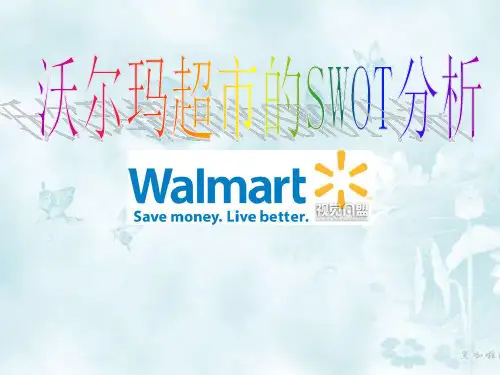
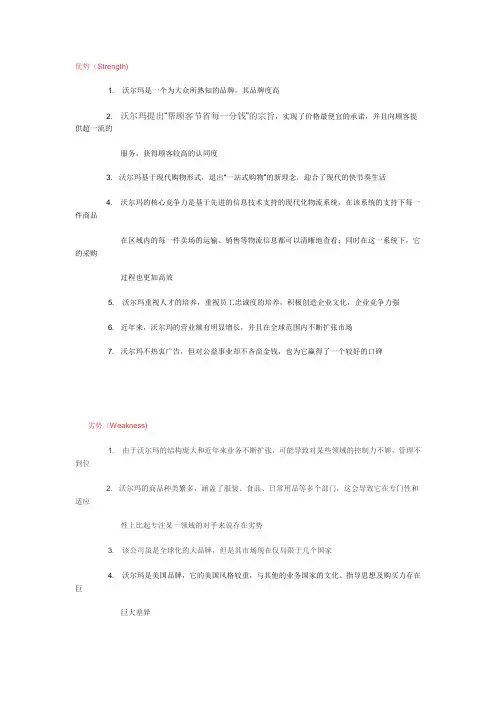
优势(Strength)1. 沃尔玛是一个为大众所熟知的品牌,其品牌度高2. 沃尔玛提出“帮顾客节省每一分钱”的宗旨,实现了价格最便宜的承诺,并且向顾客提供超一流的服务,获得顾客较高的认同度3. 沃尔玛基于现代购物形式,退出“一站式购物”的新理念,迎合了现代的快节奏生活4. 沃尔玛的核心竞争力是基于先进的信息技术支持的现代化物流系统,在该系统的支持下每一件商品在区域内的每一件卖场的运输、销售等物流信息都可以清晰地查看;同时在这一系统下,它的采购过程也更加高效5. 沃尔玛重视人才的培养,重视员工忠诚度的培养,积极创造企业文化,企业竞争力强6. 近年来,沃尔玛的营业额有明显增长,并且在全球范围内不断扩张市场7. 沃尔玛不热衷广告,但对公益事业却不吝啬金钱,也为它赢得了一个较好的口碑劣势(Weakness)1. 由于沃尔玛的结构庞大和近年来业务不断扩张,可能导致对某些领域的控制力不够,管理不到位2. 沃尔玛的商品种类繁多,涵盖了服装、食品、日常用品等多个部门,这会导致它在专门性和适应性上比起专注某一领域的对手来说存在劣势3. 该公司虽是全球化的大品牌,但是其市场现在仅局限于几个国家4. 沃尔玛是美国品牌,它的美国风格较重,与其他的业务国家的文化、指导思想及购买力存在巨巨大差异机会(Opportunity)1. 中国市场前景广阔,中国加入WTO后,加大了对外资的保护,也放宽了限制2. 沃尔玛采取收购、合并或战略联盟等方式与其他国家的零售商合作,专注于欧洲和中国等几个特大市场,而且随着这些国家或地区的经济不断发展,人们的购买力也不断提高3. 沃尔玛的卖场现在只限于几个国家内,在其先进的运行模式和强大的实力下,它可以开拓更大的市场4. 在沃尔玛巨大的零售市场占有额上,它的发展机会和方式也更广5. 沃尔玛采取的聚焦战略具有非常大的战略意义威胁(Threats)1. 沃尔玛的领头羊地位注定了它成为所有同行的赶超目标2. 沃尔玛的全球性战略可能在实行中遭遇政治这一敏感区域,从而给扩张带来巨大的阻碍3. 近年来其扩张的速度过快,可能遭致地方保护主义,不利于其健康发展4. 同行竞争者为遏制沃尔玛的扩张而发起的恶性竞争(如恶性价格竞争)5. 存在家乐福这一强大对手6. 沃尔玛的物流系统和信息系统是基于先进的信息技术前提下的,但在一些地区,由于信息系统相对落后,其先进性难以显示机会--劣势(OW)策略沃尔玛身处全球化这一巨大的坏境,对这一国际品牌来时无疑是个巨大的机会,但其对某个领域的控制力在一定程度上限制了它的进一步发展,同时它的适应性有待提高,因此,沃尔玛需用外部资源来弥补本公司内部的不足,充分利用它的品牌度和物美价廉的特点及先进的物流系统,在适当时机同一些本土企业建立战略联盟,从而在经济全球化中更好地立于主导地位,进一步提高市场占有额具体措施:1. 继续坚持良好的企业形象,开拓品牌价值2. 加强对新开拓业务的地区的控制,循序渐进3. 采取战略联盟的方式缓解一些本土品牌对外来企业的抵制4. 在坚持本身优势的前提下(如先进的信息系统和高水平的服务),打好“本土化”的牌,在特有的市场环境和社会环境来调整公司原有的制度建设 5. 加强对员工的培训,提高员工素质,增强竞争力。
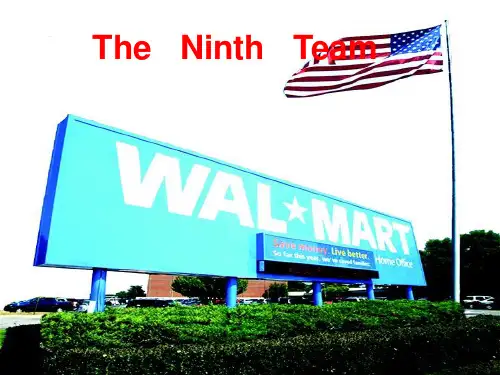

沃尔玛SWOT分析一、公司简介沃尔玛公司由美国零售业的传奇人物山姆沃尔顿先生于1962年在阿肯色州成立。
经过四十多年的发展,目前,沃尔玛在全球开设了超过7,000家商场,员工总数190多万人,分布在全球14个国家。
每周光临沃尔玛的顾客1.76亿人次。
沃尔玛1996年进入中国,在深圳开设了第一家沃尔玛购物广场和山姆会员商店。
经过十一年的发展,沃尔玛目前已经在全国共55个城市开设了104家商场,包括沃尔玛购物广场、山姆会员商店、沃尔玛社区店三种业态,其中沃尔玛购物广场99家、山姆会员商店3 家,社区店2家。
沃尔玛至今在华创造了超过50,000个就业机会。
作为一个出色的企业公民,沃尔玛自进入中国就积极开展社区服务和慈善公益活动,十二年累计向各种慈善公益事业捐献了超过3,600万兀的物品和资金。
沃尔玛十分重视环境保护和可持续发展,并把环保360的理念融入到沃尔玛日常工作的每一个环节,同时沃尔玛也鼓励合作伙伴成为沃尔玛环保360计划的一部分,共同致力于中国的环境保护和可持续发展。
与在世界其它地方一样,沃尔玛在中国始终坚持公司的优良传统,即专注于开好每一家店,服务好每一位顾客。
始终为顾客提供优质廉价、品种齐全的商品和友善的服务。
沃尔玛在中国每开设一家商场,为当地引入先进的零售技术及创新的零售观念。
在激发竞争的同时,帮助提高当地零售业的经营水平和服务质量,从而促进当地经济的共同繁荣。
优势(Strength)1. 沃尔玛是一个为大众所熟知的品牌,其品牌度高2. 沃尔玛提出帮顾客节省每一分钱”的宗旨,实现了价格最便宜的承诺,并且向顾客提供超一流的服务,获得顾客较高额认同3. 沃尔玛基于现代购物形式,退出一站式购物”的新理念,迎合了现代的快节奏生活4. 沃尔玛的核心竞争力是基于先进的信息技术支持的现代化物流系统,在该系统的支持下每一件商品在区域内的每一件卖场的运输、销售等物流信息都可以清晰地查看;同时在这一系统下,它的采购过程也更加高效5. 沃尔玛重视人才的培养,重视员工忠诚度的培养,积极创造企业文化,企业竞争力强6. 近年来,沃尔玛的营业额有明显增长,并且在全球范围内不断扩张市场7. 沃尔玛不热衷广告,但对公益事业却不吝啬金钱,也为它赢得了一个较好的口碑劣势(Weakness)1. 由于沃尔玛的结构庞大和近年来业务不断扩张,可能导致对某些领域的控制力不够,管理不到位2. 沃尔玛的商品种类繁多,涵盖了服装、食品、日常用品等多个部门,这会导致它在专门性和适应性上比起专注某一领域的对手来说存在劣势3. 该公司虽是全球化的大品牌,但是其市场现在仅局限于几个国家4. 沃尔玛是美国品牌,它的美国风格较重,与其他的业务国家的文化、指导思想及购买力存在巨大差异机会(Opportunity)1. 中国市场前景广阔,中国加入WTO后,加大了对外资的保护,也放宽了限制2. 沃尔玛采取收购、合并或战略联盟等方式与其他国家的零售商合作,专注于欧洲和中国等几个特大市场,而且随着这些国家或地区的经济不断发展,人们的购买力也不断提高3. 沃尔玛的卖场现在只限于几个国家内,在其先进的运行模式和强大的实力下,它可以开拓更大的市场4. 在沃尔玛巨大的零售市场占有额上,它的发展机会和方式也更广5. 沃尔玛采取的聚焦战略具有非常大的战略意义威胁(Threats)1. 沃尔玛的领头羊地位注定了它成为所有同行的赶超目标2. 沃尔玛的全球性战略可能在实行中遭遇政治这一敏感区域,从而给扩张带来巨大的阻碍3. 近年来其扩张的速度过快,可能遭致地方保护主义,不利于其健康发展4. 同行竞争者为遏制沃尔玛的扩张而发起的恶性竞争(如恶性价格竞争)5. 存在家乐福这一强大对手6. 沃尔玛的物流系统和信息系统是基于先进的信息技术前提下的,但在一些地区,由于信息系统相对落后,其先进性难以显示机会--劣势(0W)策略沃尔玛身处全球化这一巨大的坏境,对这一国际品牌来时无疑是个巨大的机会,但其对某个领域的控制力在一定程度上限制了它的进一步发展,同时它的适应性有待提高,因此,沃尔玛需用外部资源来弥补本公司内部的不足,充分利用它的品牌度和物美价廉的特点及先进的物流系统,在适当时机同一些本土企业建立战略联盟,从而在经济全球化中更好地立于主导地位,进一步提高市场占有额具体措施:1. 继续坚持良好的企业形象,开拓品牌价值2. 加强对新开拓业务的地区的控制,循序渐进采取战略联盟的方式缓解一些本土品牌对外来企业的抵制在坚持本身优势的前提下(如先进的信息系统和高水平的服务),打好本土化”的牌,在特有的市场环境和社会环境来调整公司原有的制度建设5. 加强对员工的培训,提高员工素质,增强竞争力战略:一、了解中国市场并做适当的调整欧美的成功经验并不完全适合中国市场。
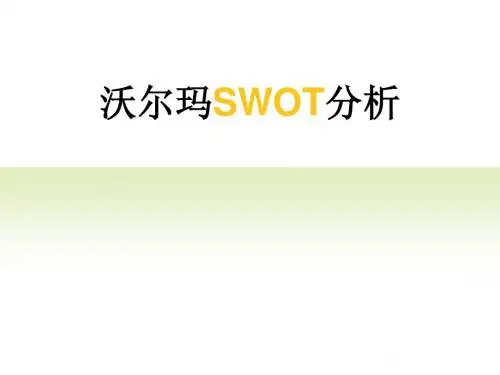
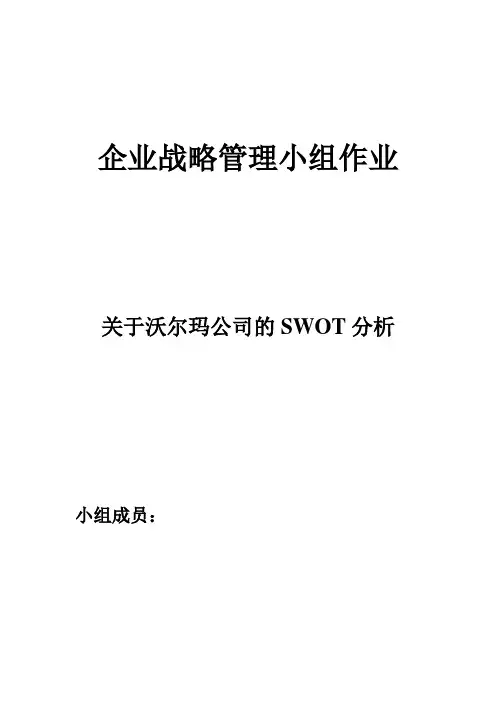
企业战略管理小组作业关于沃尔玛公司的SWOT分析小组成员:沃尔玛的企业背景:沃尔玛百货公司由美国零售业的传奇人物山姆沃尔顿先生于1962年在阿肯色州成立。
经过四十多年的发展,沃尔玛公司已经成为世界最大的私营雇主和最大的连锁零售商,在全球14个国家开设了7,000多家商场,员工总数超过200万人,每周光临沃尔玛的顾客达1.76亿人次。
沃尔玛1996年进入中国,在深圳开设了第一家沃尔玛购物广场和山姆会员商店。
沃尔玛全球采购中心总部于2002年在深圳设立。
经过十二年的发展,目前沃尔玛已经在全国共63个城市开设了115家商场,包括沃尔玛购物广场、山姆会员商店、沃尔玛社区店三种业态,其中沃尔玛购物广场110家、山姆会员商店3家,社区店2家,同时拥有好又多35%的股权。
沃尔玛至今在华创造了超过50,000个就业机会。
作为一个出色的企业公民,沃尔玛自进入中国就积极开展社区服务和慈善公益活动,十二年累计向各种慈善公益事业捐献了超过5,700万元的物品和资金。
沃尔玛十分重视环境保护和可持续发展,并把环保360的理念融入到沃尔玛日常工作的每一个环节,同时沃尔玛也鼓励合作伙伴成为沃尔玛环保360计划的一部分,共同致力于中国的环境保护和可持续发展。
与在世界其它地方一样,沃尔玛在中国始终坚持公司的优良传统,即专注于开好每一家店,服务好每一位顾客。
致力于以“天天平价”为顾客提供品种齐全的优质商品和友善的服务。
沃尔玛在中国每开设一家商场,均会为当地引入先进的零售技术及创新的零售观念。
通过促进健康竞争,我们希望不断地提高经营水平和服务质量,从而为当地经济繁荣作出贡献。
沃尔玛在中国的经营始终坚持本地采购,通过购买优质产品为当地提供更多的就业机会,支持当地制造业,促进地方经济发展。
目前,沃尔玛中国销售的产品中本地产品达到95%以上,与近2万家供应商建立了合作关系。
沃尔玛一贯视供应商为合作伙伴,与供应商共同发展。
2008年9月,在由上海商情-供应商满意度测评办公室中心发布的《2008供应商满意度调查报告》中,沃尔玛再次被评为“综合满意度最高的连锁卖场”。
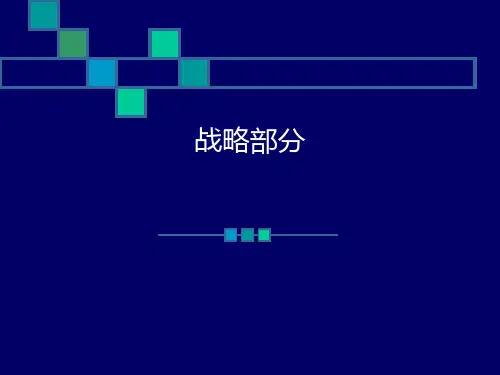
沃尔玛SWOT分析一、公司简介沃尔玛公司由美国零售业的传奇人物山姆·沃尔顿先生于1962年在阿肯色州成立。
经过四十多年的发展,目前,沃尔玛在全球开设了超过7,000家商场,员工总数190多万人,分布在全球14个国家。
每周光临沃尔玛的顾客亿人次。
沃尔玛1996年进入中国,在深圳开设了第一家沃尔玛购物广场和山姆会员商店。
经过十一年的发展,沃尔玛目前已经在全国共55个城市开设了104家商场,包括沃尔玛购物广场、山姆会员商店、沃尔玛社区店三种业态,其中沃尔玛购物广场99家、山姆会员商店3家,社区店2家。
沃尔玛至今在华创造了超过50,000个就业机会。
作为一个出色的企业公民,沃尔玛自进入中国就积极开展社区服务和慈善公益活动,十二年累计向各种慈善公益事业捐献了超过3,600万元的物品和资金。
沃尔玛十分重视环境保护和可持续发展,并把环保360的理念融入到沃尔玛日常工作的每一个环节,同时沃尔玛也鼓励合作伙伴成为沃尔玛环保360计划的一部分,共同致力于中国的环境保护和可持续发展。
与在世界其它地方一样,沃尔玛在中国始终坚持公司的优良传统,即专注于开好每一家店,服务好每一位顾客。
始终为顾客提供优质廉价、品种齐全的商品和友善的服务。
沃尔玛在中国每开设一家商场,为当地引入先进的零售技术及创新的零售观念。
在激发竞争的同时,帮助提高当地零售业的经营水平和服务质量,从而促进当地经济的共同繁荣。
优势(Strength)1. 沃尔玛是一个为大众所熟知的品牌,其品牌度高2. 沃尔玛提出“帮顾客节省每一分钱”的宗旨,实现了价格最便宜的承诺,并且向顾客提供超一流的服务,获得顾客较高额认同3. 沃尔玛基于现代购物形式,退出“一站式购物”的新理念,迎合了现代的快节奏生活4. 沃尔玛的核心竞争力是基于先进的信息技术支持的现代化物流系统,在该系统的支持下每一件商品在区域内的每一件卖场的运输、销售等物流信息都可以清晰地查看;同时在这一系统下,它的采购过程也更加高效5. 沃尔玛重视人才的培养,重视员工忠诚度的培养,积极创造企业文化,企业竞争力强6. 近年来,沃尔玛的营业额有明显增长,并且在全球范围内不断扩张市场7. 沃尔玛不热衷广告,但对公益事业却不吝啬金钱,也为它赢得了一个较好的口碑劣势(Weakness)1. 由于沃尔玛的结构庞大和近年来业务不断扩张,可能导致对某些领域的控制力不够,管理不到位2. 沃尔玛的商品种类繁多,涵盖了服装、食品、日常用品等多个部门,这会导致它在专门性和适应性上比起专注某一领域的对手来说存在劣势3. 该公司虽是全球化的大品牌,但是其市场现在仅局限于几个国家4. 沃尔玛是美国品牌,它的美国风格较重,与其他的业务国家的文化、指导思想及购买力存在巨大差异机会(Opportunity)1. 中国市场前景广阔,中国加入WTO后,加大了对外资的保护,也放宽了限制2. 沃尔玛采取收购、合并或战略联盟等方式与其他国家的零售商合作,专注于欧洲和中国等几个特大市场,而且随着这些国家或地区的经济不断发展,人们的购买力也不断提高3. 沃尔玛的卖场现在只限于几个国家内,在其先进的运行模式和强大的实力下,它可以开拓更大的市场4. 在沃尔玛巨大的零售市场占有额上,它的发展机会和方式也更广5. 沃尔玛采取的聚焦战略具有非常大的战略意义威胁(Threats)1. 沃尔玛的领头羊地位注定了它成为所有同行的赶超目标2. 沃尔玛的全球性战略可能在实行中遭遇政治这一敏感区域,从而给扩张带来巨大的阻碍3. 近年来其扩张的速度过快,可能遭致地方保护主义,不利于其健康发展4. 同行竞争者为遏制沃尔玛的扩张而发起的恶性竞争(如恶性价格竞争)5. 存在家乐福这一强大对手6. 沃尔玛的物流系统和信息系统是基于先进的信息技术前提下的,但在一些地区,由于信息系统相对落后,其先进性难以显示机会--劣势(OW)策略沃尔玛身处全球化这一巨大的坏境,对这一国际品牌来时无疑是个巨大的机会,但其对某个领域的控制力在一定程度上限制了它的进一步发展,同时它的适应性有待提高,因此,沃尔玛需用外部资源来弥补本公司内部的不足,充分利用它的品牌度和物美价廉的特点及先进的物流系统,在适当时机同一些本土企业建立战略联盟,从而在经济全球化中更好地立于主导地位,进一步提高市场占有额具体措施:1. 继续坚持良好的企业形象,开拓品牌价值2. 加强对新开拓业务的地区的控制,循序渐进采取战略联盟的方式缓解一些本土品牌对外来企业的抵制在坚持本身优势的前提下(如先进的信息系统和高水平的服务),打好“本土化”的牌,在特有的市场环境和社会环境来调整公司原有的制度建设5.加强对员工的培训,提高员工素质,增强竞争力战略:一、了解中国市场并做适当的调整欧美的成功经验并不完全适合中国市场。
沃尔玛中国营销环境SWOT分析课程名称:国际市场营销任课老师:高文香学生姓名:薛杜鹃所在班级:市场营销学号:11320092沃尔玛全球概况沃尔玛百货有限公司由美国零售业的传奇人物山姆沃尔顿先生于1962年在阿肯色州成立。
经过五十多年的发展,沃尔玛公司已经成为世界最大的私人雇主和连锁零售商,多次荣登《财富》杂志世界500强榜首及当选最具价值品牌。
沃尔玛帮助世界各地的人们随时随地都能节省开支,生活得更好,无论是在零售店、网络以及通过手机等。
每周,超过2亿名顾客和会员光顾沃尔玛在27个国家拥有的69个品牌下的10700多家分店以及遍布10个国家的电子商务网站。
2013财政年度(2012年2月1日至2013年1月31日)的销售金额达到4,660亿美元,全球员工总数超过200万名。
沃尔玛始终在可持续发展、公司慈善事业以及提供工作机会等领域担任领军者。
与在世界其它地方一样,沃尔玛在中国始终坚持“尊重个人、服务顾客、追求卓越”的核心价值观,专注于开好每一家店,服务好每一位顾客,履行公司的核心使命——“为顾客省钱,让他们生活得更好”,以不断地为我们的顾客、会员和员工创造非凡。
沃尔玛中国概况沃尔玛于1996年进入中国,在深圳开设了第一家沃尔玛购物广场和山姆会员商店。
目前沃尔玛在中国经营多种业态和品牌,包括购物广场、山姆会员商店、社区店等,截至2013年2月28日,已经在全国21个省、自治区、4个直辖市的150多个城市开设了390多家商场,在全国创造了近10万个就业机会。
沃尔玛在中国的经营始终坚持本地采购,目前,沃尔玛中国与近2万家供应商建立了合作关系,销售的产品中本地产品超过95%;同时,沃尔玛中国注重人才本土化,鼓励人才多元化,特别是培养和发展女性员工及管理层。
目前沃尔玛中国超过99.9%的员工来自中国本土,商场总经理100%由中国本土人才担任,女性员工占比超过60%,管理团队约40%为女性。
2009年公司成立了“沃尔玛中国女性领导力发展委员会”,以加速推动女性的职业发展。
一、概述(Executive Summary)(一)沃尔玛公司(Wal-Mart Stores, Inc.)简介公司名称:沃尔玛百货有限公司(Wal-Mart Stores ,inc.)创办年份: 1962年创始人:山姆·沃尔顿总部地点:美国阿肯色州-本顿维尔公司性质:综合商业员工数:210万(2010年)公司规模:全球8445家商场(2010年)年营业额:408214百万美元(2010年)美国沃尔玛公司是世界上最大的零售业巨头,创于1945年,创始人山姆·沃尔顿早期在美国一个小镇开始经营零售业,经过四十几年的努力奋斗,终于建立起全球最大的零售王国;公司总资产约2322亿美元同时在全国拥有4000多家连锁店,4000对家供应商,应有4457个仓库,并向全球2000多家商场供货,每个商场的品种平均在两万种以上,每年得销售额超过2170亿美元,其中在美国有255多家萨姆俱乐部会员店500多家,海外机构1000多家,公司已开设和即将开设的连锁店和会员店遍及巴西、加拿大中国德国英国韩国墨西哥等国员工总数达100多万人其中国际员工25万多人。
目前沃尔玛在全世界还拥有一套卫星导航信息系统,这种自己开发的集中式信息系统为沃尔玛带来了相当大的竞争优势。
(二)沃尔玛97-05年销售额二、沃尔玛零售战略的SWOT 分析(一)内部分析(Internal Analysis)1、优势分析(Strengths )(1)节约开支,天天平价,成本领先企业的经营理念,不仅仅是企业的灵魂,同时也是企业经营成败的主要因素。
沃尔玛的经营理念蕴含于其“天天平价,始终如一”的经营策略中。
“天天平价,始终如一”不仅是指一种或若干种商品低价销售,而是所有商品都以最低价销售;不仅是指在一时或一段时间低价销售,而是常年都以最低价格销售;不仅是在一地或一些地区低价销售,而是所有地区都以最低价格销售。
(2)物流循环,提高效率沃尔玛将涉及采购、存货、运输等各个点在内的物流循环链条,作为实施成本领先战略的载体,并通过对该链条的集中管理,把整个链条中各个点的成本降至行业最低。
SWOT Analysis Wal-Mart.Strengths.Wal-Mart is a powerful retail brand. It has a reputation for value for money, convenience and a wide range of products all in one store.Wal-Mart has grown substantially over recent years, and has experienced global expansion (for example its purchase of the United Kingdom based retailer ASDA). The company has a core competence involving its use of information technology to support its international logistics system. For example, it can see how individual products are performing country-wide, store-by-store at a glance. IT also supports Wal-Mart's efficient procurement.A focused strategy is in place for human resource management and development. People are key to Wal-Mart's business and it invests time and money in training people, and retaining a developing them.Weaknesses.Wal-Mart is the World's largest grocery retailer and control of its empire, despite its IT advantages, could leave it weak in some areas due to the huge span of control.Since Wal-Mart sell products across many sectors (such as clothing, food, or stationary), it may not have the flexibility of some of its more focused competitors. The company is global, but has has a presence in relatively few countries Worldwide. Opportunities.To take over, merge with, or form strategic alliances with other global retailers, focusing on specific markets such as Europe or the Greater China Region.The stores are currently only trade in a relatively small number of countries. Therefore there are tremendous opportunities for future business in expanding consumer markets, such as China and India.New locations and store types offer Wal-Mart opportunities to exploit market development. They diversified from large super centres, to local and mall-based sites. Opportunities exist for Wal-Mart to continue with its current strategy of large, super centres.Threats.Being number one means that you are the target of competition, locally and globally. Being a global retailer means that you are exposed to political proble ms in the countries that you operate in.The cost of producing many consumer products tends to have fallen because of lower manufacturing costs. Manufacturing cost have fallen due to outsourcing to low-cost regions of the World. This has lead to price competition, resulting in price deflation in some ranges. Intense price competition is a threat.'Wal-Mart Stores, Inc. is the world's largest retailer, with $256.3 billion in sales in the fiscal year ending Jan. 31, 2004. The company employs 1.6 million associatesworldwide through more than 3,600 facilities in the United States and more than 1,570 units . . .more? Go to Wal-Mart FactsDisclaimer: This case study has been compiled from information freely available from public sources. It is merely intended to be used for educational purposes only.。
沃尔玛SWOT对中国地区的市场环境分析根据国际权威市场调查公司IC Insights公布的全球厂商沃尔玛公司排名中第一,沃尔玛2010年中国内地新开门店38家,截至2010年12月23日门店总计215家。
有购物广场、山姆会员商店、社区店、惠选折扣店四种形态其中沃尔玛购物广场205家,山姆会员商店6家,社区店2家,惠选折扣店2家。
截止2010年12月23日,沃尔玛2010年中国内地新开门店37家,其中浙江1家、江苏3家、上海3家、安徽5家、河北1家、河南2家、广东4家、云南2家、四川6家、重庆1家、湖北5家、江西1家、北京1家、内蒙古1家、山东2家。
沃尔玛公司SWOT分析:一、Strengths(优势)1.沃尔玛公司司更熟悉国内的市场;2.沃尔玛公司在国内拥有良好的渠道;3.沃尔玛公司在人力成本等方面有一定比较优势。
二、Weakness(劣势)1.沃尔玛公司在新技术、新管理上的上滞后国外对手2.沃尔玛公司对中心市场不甚了解,缺乏相关经验;3.沃尔玛公司在采购上无法与国外对手竞争,缺乏整合上下游资源的能力;4.沃尔玛公司的产品质量普遍较差,缺少美誉度;5.沃尔玛公司的内部管理水平和品牌运作能力有所欠缺。
三、Opportunity(机会)1.中国依然有较大的发展潜力,且连锁超市对中国市场更为熟悉;2.中国可能会等产业联盟企业可能获得更多机会;3.印度、巴西、非洲等地新兴市场沃尔玛公司有较大发展机会;4.沃尔玛公司开始细分市场,并推出等个性化服务,可能开辟一片“蓝海”。
四、Threat(威胁)1.在国内,以沃尔玛公司开始学习中国公司重心下移的渠道模式,并已取得初步成效;2.沃尔玛公司开始实施低成本战略,推出的超低价策略,对中国市场可能造成重创。
通过以上的SWOT分析我们可以看出,沃尔玛公司公司虽然有着自己的比较优势,并在全球范围内有可以实现跳跃式发展的机会,但他们在市场的核心技术突破上集体,这个决定胜败的核心问题预计不会在短期内得到解决,那么沃尔玛公司将在比较长的时间里处于全球超市行业的第三第四阵营,而这种状况得到改善的机会又存在着诸多的不确定性。
Wal-Mart Stores, Inc.Company ProfilePublication Date: 18 Jun 2010AmericasEurope, Middle East & AfricaAsia Pacific245 5th Avenue119 Farringdon RoadLevel 46London4th Floor2 Park StreetEC1R 3DASydney, NSW 2000New Y ork, NY 10016United KingdomUSAAustraliat: +1 212 686 7400t: +44 20 7551 9000t: +61 2 8705 6900f: +1 212 686 2626f: +44 20 7551 9090f: +61 2 8088 7405e: euroinfo@e: apinfo@e: usinfo@TABLE OF CONTENTSCompany Overview (4)Key Facts (4)SWOT Analysis.....................................................................................................5Wal-Mart Stores, Inc.Page 3T ABLE OF CONTENTSCOMPANY OVERVIEWWal-Mart Stores (Wal-Mart or "the company") operates retail stores in various formats across the world. In the US, the retail formats operated by Wal-Mart include discount stores, supercenters,neighborhood markets, marketside, and Sam's Clubs. Internationally, the company operates in Argentina, Brazil, Canada, Chile, China, Costa Rica, El Salvador, Guatemala, Honduras, India,Japan, Mexico, Nicaragua, Puerto Rico and the UK.Wal-Mart is headquartered in Bentonville,Arkansas and employs 2.1 million people.The company recorded revenues of $408,214 million during the financial year ended January 2010(FY2010), an increase of 0.9% over 2009.The operating profit of the company was $23,950 million in FY2010, an increase of 5.1% over 2009.The net profit was $14,335 million in FY2010, an increase of 7% over 2009.KEY FACTSWal-Mart Stores, Inc.Head Office 702 Southwest 8th StreetBentonvilleArkansas 72716USA1 479 273 4000PhoneFaxWeb Address 408,214.0Revenue / turnover (USD Mn)January Financial Year End2,100,000EmployeesWMTNew York StockExchange Ticker Wal-Mart Stores, Inc.Page 4Company OverviewSWOT ANAL YSISWal-Mart Stores (Wal-Mart or "the company") operates retail stores in various formats across the world. In the US, the retail formats operated by Wal-Mart include discount stores, supercenters,neighborhood markets, marketside, and Sam's Clubs.The company is the largest retailer with unprecedented scale and clout which will enable it to maintain its market position and continue to gain market share from competitors. However, with over two million employees, rising labor and healthcare costs will significantly affect Wal-Mart ’s profitability.Weaknesses StrengthsBig box retailing format led to low penetration into urban areas A market leader with unprecedented scalegives a competitive advantageLitigations affect labor relations adversely Low cost leadership enabling Wal-Mart tooffer products at low price pointsT arget ’s superior merchandising capabilities to appeal more to the customers as the US economy revives Internationalization strategy —a strongfoundation for growth as the US marketmaturesThreats OpportunitiesT wo million employees increases exposure to increasing wages and high healthcare costs Outperformance of the retail sectors inemerging marketsConcentration on grocery and food willbenefit as eating at home, health andwellness trends continue to emergeVolatility in commodity prices and cost inflation will pressurize margins Growth in internet retailing to serve largermarket Increasing resistance to expansion from local organizations and authoritiesStrengthsA market leader with unprecedented scale gives a competitive advantageWal-Mart is the largest retailer in the world. By the end of January 2010, Wal-Mart had more than $400 billion in revenue, $24 billion in operating income, 8,500 stores, and nearly 1 billion square feet of space.The scale of its operations is unprecedented and there is no competitor of comparable size.The company has been expanding its clout; international operations contribute between one fourth and one half of these metrics. At about 10% and 20% of total retail and grocery sales in the US, respectively, according to figures from the U.S. Census Bureau, Wal-Mart US is an integral part of consumers' budgets.The company dominates the US retail landscape and is growing internationally at a fast pace.Wal-Mart, being a market leader, is able to replicate its best practices constantly on Wal-Mart Stores, Inc.Page 5an unmatched scale both in the US and across the world.Wal-Mart’s large scale relative to most vendors leads to favorable terms on everything from the products on its shelves to store leases and distribution agreements.These competitive advantages generate positive economic returns and market share gains. Also, Wal-Mart offers a large variety of products. Its dominant position and range of products allows the company to quickly shift the product mix to meet demand and benefit from increased sales. For example, by changing floor space allocation, Wal-Mart can benefit fromlow-income consumers' growing preference for consumable staples instead of discretionary items. Such flexibility and clout will enable the company to maintain its market position and continue to capture market share from competitors.Low cost leadership enabling Wal-Mart to offer products at low price pointsWal-Mart is a price leader and its low cost operations are enabling the company to maintain the position.The company offers its grocery products at prices about 12% lower than the market.Wal-Mart constantly flexes its bargaining muscle to lower prices.This strategy ensures a steady, recurring stream of customers for its goods, making Wal-Mart synonymous with inexpensive and this keeps constant pressure on competitors. Sam's Club also enjoys a similar reputation but on a per-unit basis, as most of its goods are sold in bulk.The company receives favorable pricing from and systematic integration with most of its suppliers which is a large part of Wal-Mart’s crucial low-cost advantage.The company generally requires suppliers to tie in to its own inventory management system and to deliver goods in the manner and timing Wal-Mart dictates, leading to impressive inventory turns (especially considering that half of revenue is from non-grocery categories). Furthermore, a no-frills store environment also improves total asset turns and limits maintenance capital investment. In addition, as a low-cost general retailer, Wal-Mart has built a reputation with consumers as a one-stop shop for good deals on a huge spectrum of merchandize.The company has been aggressively trying to further reduce stock-keeping units and lower prices. Most cost savings are likely to be passed to consumers, making Wal-Mart's low-price leadership even more difficult to surpass.Macro economic conditions have pressurized customer’s spending severely. Amid such a situation, customers are more attracted to low price value retailers.The prominence of warehouse clubs has been increasing and according to a survey conducted, 36% of the customers are shopping more often in warehouses while 43% are shopping more often in supercenters. Despite indications of some trading up, economic recovery is estimated to be relatively mild, suggesting that Wal-Mart's low-price strategy will continue to resonate with lower-income consumers. Due to its positioning, the company has benefited more than most peers from consumers trading down.Wal-Mart primarily serves less-affluent consumers, but the recession has put more people in that bucket, and many are drawn to Wal-Mart’s low-cost leadership.The company’s price leadership ensures a large addressable market, which will drive top-line growth.Internationalization strategy—a strong foundation for growth as the US market maturesWal-Mart has been increasingly focusing on establishing its presence strongly in the international arena.The company operates 4,068 units in 14 countries.Wal-Mart opened its first international store in Mexico in 1991 and has grown both through acquisitions and its own innovation.Though it Wal-Mart Stores, Inc.Page 6is synonymous with the big-box stores in the US, the company has nine international store formats ranging from relatively tiny Bodega Aurrera Express stores in Mexico to a cash-and-carry warehouse in India to the traditional box in Canada. It operates under 55 different banners-Acuenta in Chile, Asda in the UK and Seiyu in Japan.Wal-Mart’s focus on international growth has enabled it to achieve a milestone by surpassing the $100 billion net sales mark for the year.Wal-Mart's international division is its fastest growing segment and this is expected to continue at an aggressive pace through strong organic growth and acquisitions. In FY2010, Wal-Mart added more than 500 units, all from organic growth.As the markets in the US saturate for Wal-Mart, the international strategy helps the company to improve returns.The risk profile of more mature markets like the UK helps provide the balance for significant growth opportunities in emerging markets like Brazil, China and India. International revenue growth more than offset a modest decrease in the US comparable-store sales. International segment revenue (25% of total) grew 9% on a currency-adjusted basis, and similar growth rates are expected for medium term as Wal-Mart redirects capital spending from the US to faster-growing markets such as Latin America and China. As it expands at the international level, not only will the company be able to replicate the business model and leverage on the expertise, but also will leverage on the global scale through global brand and supplier relationships and merchandising efficiencies.Wal-Mart is effectively participating in the high growth of emerging markets as its competitors like T arget lack the advantage. International strategy gained prominence for Wal-Mart as the opportunities for growth in the core US markets slowed.WeaknessesBig box retailing format led to low penetration into urban areasWal-Mart is a big box retailer and operates supercenters which require large space for every new store.This is limiting expansion of Wal-Mart stores in urban areas where there is limited space available and limited commercial spaces which can provide such large spaces.Wal-Mart’s massive stores can combine a grocery store and a discount store under one roof. Building huge stores made sense when suburban landscapes were wide open and baby boomers were moving away from cities. Easy access to credit fueled customer demand for larger homes and all the trappings that went with them. But trends now suggest that big stores are less attractive. Baby boomers are scaling back, moving into smaller homes closer to urban areas.The housing market crash also means new neighborhoods are not springing up to support retail centers.With the latest urban focus, retailers are expected to invent formats that differ dramatically from current ones.Although the company’s management believes that there are several opportunities to grow in the metropolitan areas in the US, the availability of space limits such scope for expansion.The strength of Wal-Mart’s business model lies in operating large retail stores and smaller formats might not be able to complement the current business model.Wal-Mart has earlier experimented with new format and opened convenience-sized grocery stores called Marketside in 2008. But the concept is on hold, indicating the company is yet to find a suitable format. Furthermore, as the company expands its large format stores, it is leading to cannibalization of existing stores.The negative impact onWal-Mart Stores, Inc.Page 7comparable store sales as a result of opening new stores was approximately 0.6% in 2010 and 1.1% in 2009.To avoid such negative effects, Wal-Mart planned slower new store growth, once again limiting the scope for expansion.Therefore, it has become increasingly important for Wal-Mart to innovate a format that can use its current strengths and is more suitable to the urban locations. Its competitors like Target and Costco are also focusing on inventing new sustainable smaller formats, and success with the new formats will be a competitive disadvantage for Wal-Mart.Litigations affect labor relations adverselyWal-Mart has been facing several charges and law suits with respect to labor relations. In FY2009, the company settled 63 wage-and-hour class action lawsuits. As a result of the settlement, Wal-Mart recorded a pre-tax charge of approximately $382 million during Q4'2009.Wal-Mart also is still involved in the Duke’s gender discrimination suit, which was filed by its female retail employees alleging that the company has paid them less and has promoted them less often than male employees. In this case as many as 1.5 million women who have worked at Wal-Mart's US stores anytime since December 26, 1998 will be represented and compensated in case it is proven.Wal-Mart has been suffering the ill-effects of such law suits which divert large amounts of money towards counterproductive activities. Additionally, the company’s reputation is tarnished and will find itself short of skilled and qualified employees.The employees might demand higher compensation and will also lead to skilled employees choosing to work with competitors, which will be a key competitive disadvantage.T arget’s superior merchandising capabilities to appeal more to the customers as the US economy revivesT arget has over the years focused on differentiating itself against the competition, specifically against Wal-Mart, through the merchandise it offers.T arget benefited from the image of being a purveyor of affordable yet stylish products. It made deals with well-known designers who made frugal, fashionable clothes for the company, which were viewed as little bit more upscale than that ofWal-Mart’s. In a study conducted by William Blair and Company, it was observed that Target had a superior merchandise selection compared to Wal-Mart across various parameters.Target led in the depth of merchandise assortment across several product categories. It also has considerable advantage in the product assortment in home and hardlines. In both of these categories, Target also led Wal-Mart inbrand variety and brand assortment available in its stores.Target offers merchandise across several price points and offers a wider range of price points between the opening price and highest-end items. In this parameter of the merchandise available in several parameters, T arget led across several categories including home, hardlines, apparel and electronics. Although, customers in recent times have been trading down and Target has found it increasingly difficult to compete with Wal-Mart, the strong merchandising is a key differentiator as consumer spending starts increasing. The strong assortment and its strategy to stock brands and products at different price points is likely to be a strength as the economy recovers, as Wal-Mart will be able to increasingly sell higher end products. Also, its merchandising is enabling Target to charge a premium and increase its margins. Wal-Mart has geared up efforts to compete with T arget on merchandising. However, Target still leads in merchandising and Wal-Mart’s product assortment although available at lower prices might be less appealing to the customers as the economy recovers and consumers start spending.Wal-Mart Stores, Inc.Page 8OpportunitiesOutperformance of the retail sectors in emerging marketsWal-Mart has presence in several emerging economies and the positive retail trends in these economies will positively impact revenue growth. Asia’s retail sales are estimated to increase with China driving the growth. China's retail sales are estimated to grow at 16% in 2010. China's retail sales rose 17.9% and stood at CNY2.5052 trillion ($366.9 billion) in January and February of 2010 according to latest figures released by the National Bureau of Statistics (NBS). On a year-over-year basis, Brazilian retail sales have risen 12.3% in February 2010 and the sales are expected to grow at a fast pace for rest of 2010. Similarly, modern retail in India is estimated to make up just 5% of the market but is growing at 30% a year.Economists have long predicted that consumers in emerging economies would not only manufacture most of the world's goods but also buy them. Foreign sales account for roughly 30% of revenue of S&P 500 companies, up from 20% a decade ago. By 2014, the IMF forecasts, emerging economies will contribute more to the world economy than developed nations.Wal-Mart’s bigger focus during the downturn has been on wringing out costs to drive down prices.That has eaten away at revenue, and gas prices have hurt traffic. Although other retailers have seen consumers begin to relax,Wal-Mart’s low-income, core customers are paying with food stamps and unemployment benefits than a year ago. In contrast to this uncertainty in the US, growth in emerging economies indicate strong returns.Though other countries in which Wal-Mart operates also were hit by the recession, the downturn was not as severe and the recovery has been more robust.The IMF expects the US economy to grow 3.1% in 2010. During the same time, Mexico's is predicted to expand 4.2%, Brazil to rise 5.5%, and China to hit 10% indicating strong growth rates in all countries in which Wal-Mart has invested heavily. For developing countries accustomed to informal markets, such as mom-and-pop shops and street vendors where prices can change daily, Wal-Mart and its likes are expected to meet a resistance among the customers. However, the company is accustomed to such environments as experts believe that Wal-Mart's early strategy of building stores in a rural America neglected by other retailers is in similar lines and its experience will provide it with necessary expertise to penetrate in these emerging markets.These outperforming sectors in the emerging markets will drive the growth for Wal-Mart as its core US market matures.Concentration on grocery and food will benefit as eating at home, health and wellness trends continue to emergeEating at home and eating healthy are important trends that are likely to increase the demand for grocery. For the year ending (Y/E) in February 2009, Americans prepared and consumed nearly two thirds of their meals at home, which is up five meals per person compared to the prior year.The economic downturn, the perception that home-prepared foods are much healthier—a view held by 92% of grocery shoppers, according to an industry study—and an unmet desire to enjoy affordable, restaurant-style foods at home have given food marketers the opportunity to recapture mealtime. With 84% of food shoppers cooking more at home in 2009 and 40% planning to do so more often Wal-Mart Stores, Inc.Page 9in 2010, basic ingredients like rice, breakfast meats, frozen poultry, oils/shortening, and frozen vegetables are estimated to enjoy brisk sales.Despite the economy, industry reports suggest that the perishable department is growing faster than all retail sectors in the total market. Household deli spending for the year ending September 2009 was up 5% over last year; bakery, up 3%; fresh meat/seafood, up 4%; and produce, up 3%. Sales of frozen foods are estimated to grow and are projected to reach $65 billion by 2013.This growth is driven by the consumer’s perception of healthy food, increasing working population with lesser time to cook and also increased meal options provided.These trends suggest a large potential market, the spending in which is not entirely discretionary.Additionally, self-care has emerged as a key money-saving strategy, which is driving the health and wellness trend in the US. Another industry report suggests that nearly three-quarters of consumers rate nutritious/wholesome meals as a major consideration when planning food and beverage shopping trips and that two-thirds are eating to manage specific health conditions. Also, sales of food carrying a natural claim reached $20.4 billion for year ending April 2009, up 6.6%; sales of products with a “no preservatives” callout reached $13 billion, up 8%.This indicates a growing demand for healthy and natural food products. Customers in the US have are more health conscious now than before and the trend has impacted the preference of food products. It has been observed that 77% of consumers read ingredient statements on packaging and are using nutritional information to make their purchasing decisions.Additionally, the food and grocery segment will increase the guest traffic into the stores converting into higher sales.The net sales of Wal-Mart US increased in FY2010, owing partly to the strength of company’s grocery and health and wellness categories. Similar increases have been witnessed in the fresh food and consumables and certain health and wellness categories in Sam’s Club. Also, gross profit margin for Sam’s Club increased 0.6 percentage points during 2010 compared to the prior year due to continued strength in sales of consumable, fresh food and other food-related categories. Although, Wal-Mart has been a multi-line retailer it has pro-actively increased the share of groceries and food products in the total sales.The positive trends in the market will lead to increased sales in the segment which have higher margins driving the profitability as well.Growth in internet retailing to serve larger marketOnline retailing has been increasing at a fast pace in the US. Although in 2009 growth stalled in the country, and recorded a low growth rate of 2%, the online retail sales still contributed to 7% of the total retail sales in 2009 and are expected to further increase.The US market, by 2014 is expected to reach a value of $13.55 billion, which represents an increase of almost 75% compared with levels in 2009, according to industry reports. Although, the share of grocery in the total online sales is estimated to be 2%, the high growth market gives Wal-Mart an opportunity to reach out to wider audience and increase customer base. In addition, the online channel has several counter recessionary characteristics like low infrastructure costs which can be passed on to the consumers, and ’s traffic exceeded one billion visits in 2009, growing more than 15% over the previous year through Site-to-Store and home delivery. In saturated markets where its format has limited expansion models, online channel will be a crucial expansion.With the help of Wal-Mart Stores, Inc.Page 10technology, Wal-Mart aims at achieving its long-term target of serving over a billion customers in a week in the coming 20 years, compared with the 200 million customers it now serves every week. The company has been focusing on establishing a strong presence in the online segment and the growing popularity of the channel will facilitate such expansion.ThreatsT wo million employees increases exposure to increasing wages and high healthcare costsThe labor costs for companies have been rising as the healthcare costs and wages increase in the recent times.Tight labor markets, increased overtime, government mandated increases in minimum wages and a higher proportion of full-time employees are resulting in an increase in labor costs, which could materially impact the company's results of operation. In the US, the government increased the minimum wage rate from $6.55 per hour in 2008 to $7.25 an hour in July 2009.The government revised the labor rates for the third year in a row. Furthermore, many states and municipalities in the country have minimum wage rate even higher than $7.25 per hour due to higher cost of living. In addition to this, the health care costs for employers in the US are increasing. According to industry estimates, health-care costs for the US employers are estimated to increase by 9% in 2010.The medical cost increases continue to outpace inflation and wage increases, and is even higher than the health-care inflation rate for the nation as a whole, at 6.9% in 2009. One of the key drivers expected to increase medical costs in 2010 is that the workers are concerned about losing their jobs and potentially their health insurance and therefore are using their health care more while they still have it.The new healthcare reforms are bringing more people under the gamut of insurance further increasing the costs for employers.These trends have several negative implications for the company. Foremost is Wal-Mart's huge employee base of just over 2 million, which leaves the firm susceptible to wage and health-care cost trends, discrimination lawsuits.With 2 million people on the payroll, overall wage and benefit cost trends are large drivers of the company’s profitability. Over the past 10 years, selling, general, and administrative costs have outpaced revenue growth, offset by other efficiencies, leading to roughly stable operating margins. If revenue growth were to fall below total labor cost inflation or Wal-Mart could no longer squeeze savings out of its supply chain, the rising costs will materially impact the profitability of Wal-Mart. During the next five years, the company further expects to create 500,000 jobs and the rising costs pose considerable threat for the company due to its large employee base.Volatility in commodity prices and cost inflation will pressurize marginsThe inflation for producers has been increasing at a faster pace than consumer’s inflation leading to higher costs for the producers.The cost inflation returned and the food and grocery industry has little pricing power, the factors which have been pressurizing margins. Although the retailers have been witnessing cost they have not been able to fully pass through the price increases.The spread between Consumer Price Index (CPI) and Producer Price Index (PPI) is at the largest negative spread in over twenty years, indicating high PPI compared to CPI, underscoring the margin pressure in the grocery industry. For the month of March 2010 PPI was up 6.8% while CPI was down -0.7% Wal-Mart Stores, Inc.Page 11creating a spread of -7.5%, the highest in the past twenty years. Rapid inflation and fluctuations can cause gross margin shortfalls as grocers have difficulty passing through cost increases.Commodity prices in meat, milk and eggs are showing enormous volatility, and as customers are price sensitive it is not always possible to pass on the rise in costs. Price wars between competitors will ensure that customers are offered products at the lowest price possible. As inflation increased and the shelf price increased, some demand destruction was seen.Therefore, volatility in commodity prices and rising cost inflation will affect margins adversely. Deflation in grocery could have a negative impact on Wal-Mart and it increases the reliance on continually wringing efficiency out of operations and forces lower selling prices from suppliers, which might not be possible for the company. As the US economy is slowly recovering, Wal-Mart has once again resorted to price cuts and announced price rollbacks on 10,000 SKUs in April 2010.The manufacturers are expecting requests fromWal-Mart for price relief to support the pricing plans, and this might not materialize as PPI increases for grocery and food products manufacturers.This is estimated to further increase an already existing quiet battle between grocery retailers and consumer packaged goods manufacturers over retail shelf prices.The weak pricing environment for Wal-Mart, increasing PPI and deflation at the consumer's end will severely affect margins for Wal-Mart.Increasing resistance to expansion from local organizations and authoritiesFor several years now, Wal-Mart has been facing severe resistance from several groups when it plans to open new stores. Several of these reports have been affecting the decisions made by local authorities which is deterring the expansion plans of Wal-Mart. A review and analysis by an industry related report suggested that on the average, a Wal-Mart store gets 84% of its business from existing stores. Another report documented that Wal-Mart has received more than $1 billion in subsidies from state and local governments through tax breaks and paying for roads and utility connections at many of its new stores. A market analysis report estimated that for every new Wal-Mart super center that opens, two local supermarkets will close.The Wall Street Journal reported that 51% of Wal-Mart ’s sales come from groceries, which do not generate any sales tax revenue for the city.Additionally, several labor issues that Wal-Mart is involved in is leading to severe opposition from the unions. In many cases, the pitched battles with the local organizations and authorities have more than doubled the amount of time it takes Wal-Mart to open a store. And the fights generate negative publicity as well. Local authorities have been forced to consider giving permits on several occasions delaying the projects. For instance in 2010, the City Council Zoning Committee in Chicago, short on votes, once again deferred a vote on a massive development on the Far South Side that would include Chicago's second Wal-Mart, to give Chicagoans more time to analyze this study, on Wal-Mart before the council takes a decision.The Milpitas City Council denied Wal-Mart ’s bid for a nearly 18,500-square-foot expansion at its Ranch Drive location that would also have allowed liquor sales,groceries and 24-hour operation. It is becoming increasingly difficult for Wal-Mart to open new stores as the resistance increases.This is affecting the new investments and the time to open new stores for the company.Wal-Mart Stores, Inc.Page 12© DatamonitorWal-Mart Stores, Inc.SWOT Analysis。